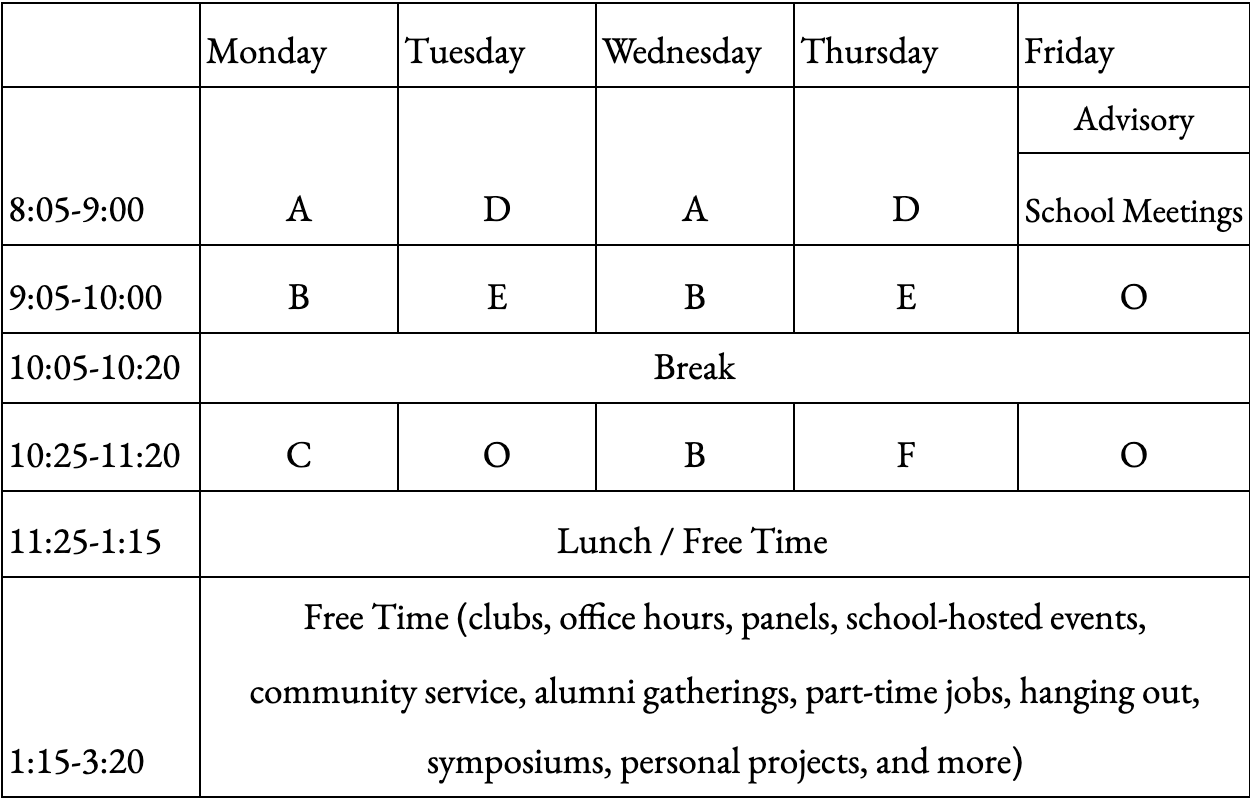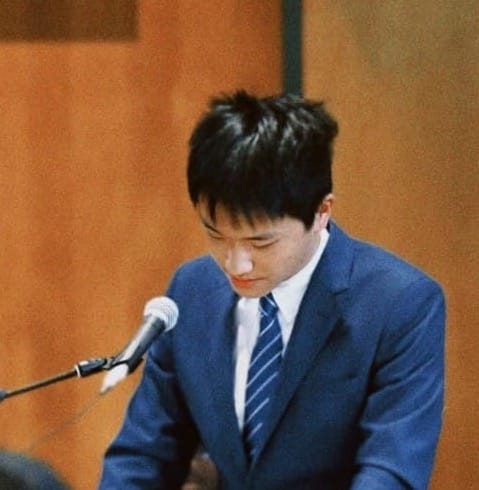High schools seek to create a community in which individuals develop competence, confidence, and character.” Yet, students consistently fail to attend school-wide events; graduates rarely return to campus; AI is replacing our education; and, drowning in schoolwork, students wait until the spring of senior year to do anything meaningful. Additionally, whereas AI and the A-student both follow instructions well, the new world requires leaders with initiative and emotional intelligence to drive change. Students, rather than being swept up in a river of schoolwork, need free time to develop initiative and mature through conversations, friendships, break-ups, sports games, failures, and experiences outside the classroom.
Therefore, to prepare students for the AI era, education systems should implement a three-hour academic day that emphasizes rather than denies free time:

The general schedule across schools consists of classes that drag students' barely awake selves and then submerge them in homework the moment they collapse in their rooms. As a sophomore student puts it, “it’s one thing after another,” and it makes students feel “exhausted” and “overwhelmed.” On the other hand, this new schedule gives them four prime hours of free time during the school day: the homework that keeps students up until 2 AM now flows into their new four-hour free time; laboratory work is no longer a scheduling crisis; and that impromptu trip to Starbucks suddenly becomes possible. In addition, students would easily attend fun school-hosted events and dedicate time to community service, two school activities that are consistently underattended.
Additionally, flexible personal productivity systems, which form the foundation for self-agency, would replace forced study halls for boarding communities. A boarder studying in Boston “much prefers” this new schedule, where they can work during their prime afternoon hours, over the current nighttime system. Similarly, another boarder anonymously added that loud, shared environments in which “packs of students cheat with ChatGPT” are incredibly disheartening and unproductive.
Beyond immediate benefits to student life, this free time also presents an opportunity to both boost the notion of the school “community” and allow students to “develop competence, confidence and character.” The schedule would no longer constrain student organizations to brisk meeting periods. With the drastic increase in time, student club leaders could initiate larger inter-club projects. Imagine a collaboration between the Programming, Entrepreneurship, Math, and Investment clubs on coding, planning/marketing, analysis, and funding a startup together, or a multitude of social initiative clubs could create a garden that grows fresh food for dining halls. These projects would “develop competence” in far more sophisticated ways than short classroom assignments can, and they would “develop…confidence and character” in a profound manner, especially when difficulties arise. Finally, these initiatives would be student-led, allowing students to interact with others of adjacent interests and develop the agency to take action themselves.
Additionally, this extra time could also allow students to connect with various alumni. For example, students could attend small-group panels based on their interests, where they would have the opportunity to directly interact with industry professionals and academics – a far more impactful experience than mandatory and crowded lectures.
Furthermore, discussions, mentorship programs, individual studies, and part-time jobs – activities that would develop real-world skills better than any sandboxed class would – could finally come to life and have dedicated time to take place. Therefore, rather than waiting for summer vacation, when everyone is scattered across the globe, students could engage in long-term projects throughout their high school years. This way, students would develop the key skills of self-agency, collaboration, and impact throughout our high school careers.
Nevertheless, some may rightfully question whether the significant reduction in class time would impact academic rigor. However, in the AI era, where the value of a college diploma – the embodiment of academic rigor – is declining, the value of independence is rising. The opportunity cost of the time needed for increased rigor – time that could be used to strengthen communities, boost student health, and provide students with opportunities for initiative – far outweighs the value of depreciating academic skills. Furthermore, according to Parkinson’s Law, the decrease in class time would act as a forcing function for rapid curriculum change. Academic departments, as exemplified by certain departments’ adaptations and additions to courses, are already working hard to compensate for the brief arrival of the AI age. This schedule would only align with educational needs by helping hone the skills required in the new world.
Particularly, limited class time would prompt an emphasis on irreplaceable collaboration skills, such as Harkness discussions, joint problem-solving, laboratory experiments, and group design. True growth happens in impromptu moments – when the class suddenly turns into a debate about AI, or the Harkness table shifts from the book to the human condition – not in hour-long lectures.
In contrast to collaborative activities, theoretical understanding can be built outside the classroom: math, science, and grammar can be learned with videos and practice problems; writing with take-home essays and feedback (though cheating would remain an issue); history with video lectures and questions for thought; and computer science with tutorials and projects. Should a student have a question, AI tutors and Google are always available. Additionally, with four hours without classes, teachers would have more available office hours to provide help.
However, to preserve the large chunks of free time, the main benefit of this schedule, homework must remain limited to current standards. Teachers foresee a dystopia; they observe students struggling through readings, where “most of the work [is] shifted home,” defeating the entire purpose of the schedule. This change necessitates more rigorous enforcement of homework length and the removal of the “my class is the most important” philosophy, which many students perceive as prevalent among teachers.
Therefore, some material would need to be cut – units which, while thought-provoking, may not be necessary foundations for the higher-level intellectuality or express the key ideas of the course.
Despite this reduction, though, the impact on academics can be minimized; Alpha High School, which only contains three hours of academics a day, still maintains a high average SAT score of 1410 (including all four grades; seniors have an average of 1530), a score well above the national average of 1024. Additionally, 53% of their AP Exam scores were a 5. While standardized test scores do not fully reflect academic rigor, these high scores demonstrate a level of academic competence comparable to that of even the most rigorous high schools.
In addition, while this schedule change would be drastic, educators have already proven their adaptability. During the onset of the pandemic, some elementary schools were able to create a digital education experience within just two weeks. Schools have quickly adopted Zoom and Microsoft Teams during those chaotic years. Furthermore, a majority of schools are already piloting educational AI software, and as evidenced by new college courses, are revamping assignments for the AI era. However, beyond preventing cheating, schools must now prepare students for the rapidly changing world. We need a change in education now, when our futures are in jeopardy, just as swiftly as that of the COVID years.
Therefore, in most schedules, the overwhelmed student, drowning in schoolwork, exhausted by torturous lectures, and not given a second for themselves, suffers in the privilege of the high school experience. And, for all their efforts, if nothing changes, they will fail to achieve their educational dream, as employers will replace white-collar, instruction-following work with AI. In contrast, with the new three-hour academic day, the now unburdened student has the free time to pursue their passions through cross-club projects or alumni mentorship, thereby developing the skills needed to thrive in the AI era. Furthermore, our previously under-engaged community can now participate in school-hosted activities or community service without a scheduling nightmare. Hence, to develop the strong community and competence required for the AI-age, high schools must adopt a three-hour academic day.





